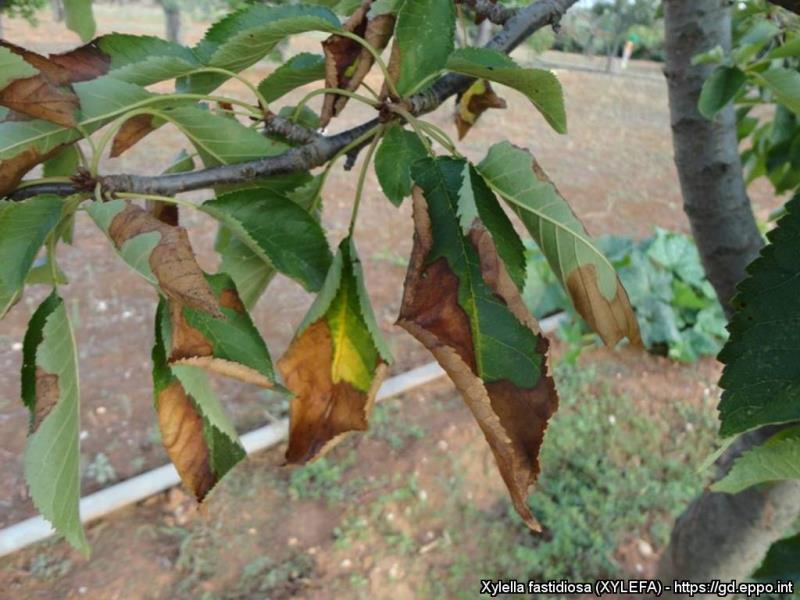Xylella fastidiosa as a bacterial pathogen that, if it reaches the UK, has the potential to have huge implications for the UK horticultural trade.
The new controls require anyone importing plants from the EU to ensure that they are accompanied by a valid plant passport confirming they have been sourced from disease-free areas/sites.
X.fastidiosa (subspecies pauca) was initially confirmed in Europe in 2013 causing devastation to olive plantations in Italy. It has since been found in a number of host species in France and Corsica in 2015 (subspecies multiplex). 2016 has seen two new countries added to the host range, including Germany in summer 2016 (subspecies faIstidiosa), Spain (Majorca) in October 2016 (subspecies fastidiosa) and the Spanish mainland (Alicante Province).
The different hosts are as follows, with new hosts recorded on a frequent basis:
| ???????????? Annex 1 host plants found to be susceptible to X. fastidiosa in the Union territory and must be plant passported | ||
Xylella fastidiosa subsp. fastidiosa | Xylella fastidiosa subsp. multiplex | Xylella fastidiosa subsp. pauca |
Nerium oleander L. Polygala myrtifolia L. Prunus avium L. Rosmarinus officinalis L. Streptocarpus Erysimum | Acacia dealbata Link Acer pseudoplatanus L. Anthyllis hermanniae L. Artemisia arborescens L. Asparagus acutifolius L. Calicotome villosa (Poiret) Link Cistus creticus L. Cistus monspeliensis L. Cistus salviifolius L. Coronilla valentina L. Cytisus scoparius (L.) Link Genista x spachiana (syn. Cytisus racemosus Broom) Genista corsica (Loisel.) DC. Genista ephedroides DC. Hebe Helichrysum italicum (Roth) G. Don Lavandula angustifolia Mill. Lavandula dentata L. Lavandula stoechas L. Lavandula x allardii (syn. Lavandula x heterophylla) Metrosideros excelsa Sol. ex Gaertn. Myrtus communis L. Pelargonium graveolens L'Hér Phagnalon saxatile (L.) Cass. Polygala myrtifolia L. Prunus cerasifera Ehrh. Prunus dulcis (Mill.) D.A Webb Quercus suber L. Rosa x floribunda Rosmarinus officinalis L. Spartium junceum L. | Acacia saligna (Labill.) Wendl. Asparagus acutifolius L. Catharanthus Chenopodium album L. Cistus creticus L. Dodonaea viscosa Jacq. Eremophila maculata F. Muell. Erigeron sumatrensis Retz. Erigeron bonariensis L. Euphorbia terracina L. Grevillea juniperina L. Heliotropium europaeum L. Laurus nobilis L. Lavandula angustifolia Mill. Lavandula stoechas L. Myrtus communis L. Myoporum insulare R. Br. Nerium oleander L. Olea europaea L. Pelargonium x fragrans Phillyrea latifolia L. Polygala myrtifolia L. Prunus avium (L.) L. Prunus dulcis (Mill.) D.A. Webb Rhamnus alaternus L. Rosmarinus officinalis L. Spartium junceum L. Vinca Westringia fruticosa (Willd.) Druce Westringia glabra L. |
Coffea plants have been found to be susceptible to several subspecies of Xylella fastidiosa.
The host list is likely to increase and includes trees, shrubs and herbaceous plants. for the latest list.
How can the industry help?
- Ensure that plant passports arriving with plants are correct and keep the plant passport to aid trace back if necessary. This may also support assurance schemes your business may be in.
- Source from known suppliers or visit suppliers to view their processes, procedures, bio-security arrangements and the plants they grow.
- Make sure that imported plants both originate from and are sourced from disease free areas. Details on infected areas at http://ec.europa.eu/food/plant/plant_health_biosecurity/legislation/emergency_measures/index_en.htm.
- Isolate or quarantine new batches of plants and monitor them during the growing season for signs of the disease–whilst not a legal requirement it is good practice to place ‘imported’ hosts of Xylella in a quarantine area –ideally a good distance away from other host plants and if possible place under physical protection. If any outbreak is confirmed all ‘host’ material within 100m will need to be destroyed.
- Label and keep records of the identity of all received batches of plants including: where the plants came from and when.
- Maintain records of pesticide treatments.
- Destroy old or unusable plants.
- Comply with the UK national requirements to notify the UK Plant health Service about certain species of plants under the ‘EU Plant and Tree notification scheme’.
For full details of the APHA guidance, please refer to their .
